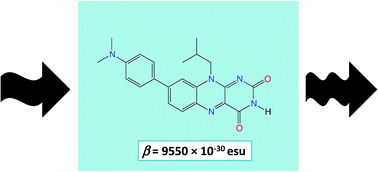Synthesis and characterisation of push–pull flavin dyes with efficient second harmonic generation (SHG) properties†
Abstract
Organic compounds displaying second-order non-linear optical properties are key materials for optoelectronics. Here, three push–pull flavin derivates (FLA-A–C) have been synthesised and their optical, redox and second harmonic generation (SHG) properties have been investigated. In particular, we describe the role differing electron donor units (N,N-dimethylaniline-, N,N-diphenylaniline- and ferrocenyl-) attached through the C(8) position of the flavin unit have on the optical and redox properties of the latter. Hyper-Rayleigh scattering in dioxane solutions using a fundamental wavelength of 1064 nm was employed to evaluate their second-order nonlinear optical properties. Our experiments have indicated that their first hyperpolarisabilities (β) are influenced by the electronic nature and strength of the donor groups. N,N-dimethylaniline-functionalised derivative FLA-A, exhibited the largest first hyperpolarisability (β = 9550 × 10−30 esu, using the T convention) and high decomposition temperature (Td = 312 °C), thus indicating its potential application as a useful material for incorporation into non-linear optical devices.



 Please wait while we load your content...
Please wait while we load your content...